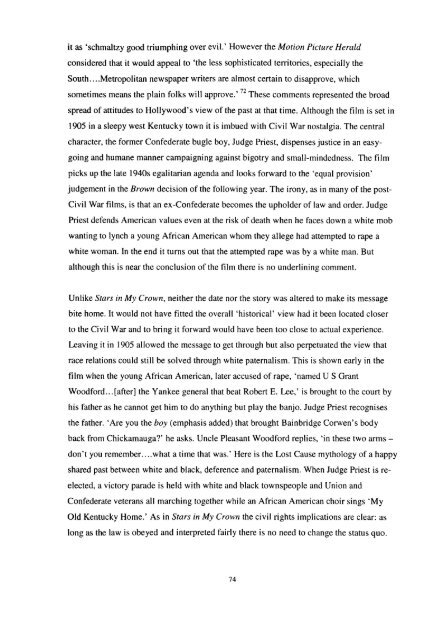Download (3483kB) - Greenwich Academic Literature Archive ...
Download (3483kB) - Greenwich Academic Literature Archive ...
Download (3483kB) - Greenwich Academic Literature Archive ...
- No tags were found...
You also want an ePaper? Increase the reach of your titles
YUMPU automatically turns print PDFs into web optimized ePapers that Google loves.
it as 'schmaltzy good triumphing over evil.' However the Motion Picture Heraldconsidered that it would appeal to 'the less sophisticated territories, especially theSouth....Metropolitan newspaper writers are almost certain to disapprove, whichsometimes means the plain folks will approve.' 72 These comments represented the broadspread of attitudes to Hollywood's view of the past at that time. Although the film is set in1905 in a sleepy west Kentucky town it is imbued with Civil War nostalgia. The centralcharacter, the former Confederate bugle boy, Judge Priest, dispenses justice in an easy-going and humane manner campaigning against bigotry and small-mindedness. The filmpicks up the late 1940s egalitarian agenda and looks forward to the 'equal provision'judgement in the Brown decision of the following year. The irony, as in many of the post-Civil War films, is that an ex-Confederate becomes the upholder of law and order. JudgePriest defends American values even at the risk of death when he faces down a white mobwanting to lynch a young African American whom they allege had attempted to rape awhite woman. In the end it turns out that the attempted rape was by a white man. Butalthough this is near the conclusion of the film there is no underlining comment.Unlike Stars in My Crown, neither the date nor the story was altered to make its messagebite home. It would not have fitted the overall 'historical' view had it been located closerto the Civil War and to bring it forward would have been too close to actual experience.Leaving it in 1905 allowed the message to get through but also perpetuated the view thatrace relations could still be solved through white paternalism. This is shown early in thefilm when the young African American, later accused of rape, 'named U S GrantWoodford...[after] the Yankee general that beat Robert E. Lee,' is brought to the court byhis father as he cannot get him to do anything but play the banjo. Judge Priest recognisesthe father. 'Are you the boy (emphasis added) that brought Bainbridge Corwen's bodyback from Chickamauga?' he asks. Uncle Pleasant Woodford replies, 'in these two arms -don't you remember....what a time that was.' Here is the Lost Cause mythology of a happyshared past between white and black, deference and paternalism. When Judge Priest is re-elected, a victory parade is held with white and black townspeople and Union andConfederate veterans all marching together while an African American choir sings 'MyOld Kentucky Home.' As in Stars in My Crown the civil rights implications are clear: aslong as the law is obeyed and interpreted fairly there is no need to change the status quo.74
















